James D. Nations
Through line = The connecting theme, the spine, the thread that connects people to their objective and pushes them forward.
“Take care of the forest, like before, like the ancestors did. Take good care of the forest.” Years ago, when linguist Suzanne Cook asked Chan K’in, a Lacandón Maya Elder, what message he had for the rising generation of Lacandón children, that was his answer, fast and clear.

Elías Tárano stands atop Chäk Aktun mountain in front of Lake Ts’ibanaj and Lake Mensäbäk, Chiapas, Mexico. Photo: James D. Nations, 2009
During the centuries that Lacandón Maya families have lived in the rainforest of eastern Chiapas, Mexico, they have shown respect for their ecosystems by embracing a life of sustainability—life for the long haul—largely because they know that their own survival depends on it. Lacandones have always lived inside the forest, rather than destroying the forest in order to live. Their children learn time-tested techniques for producing food and shelter by helping their parents with the work of daily life: planting and harvesting crops and gathering materials from the forest for tools, housing, and religious ceremonies.

Brothers Bor and Chan K’in Valenzuela at home in the Lacandón community of Mensäbäk. Photo: James D. Nations, 2017
These practical lessons are reinforced by fables in which animals talk to humans and ancestors talk with spirits that wander forest trails. The stories remind both children and adults that they should protect the forest as if their lives were intertwined with it. “Because,” the creatures tell them, “they are.”
At night, when a child convinces a tired parent to tell yet another story, she’s getting more than entertainment around the fire. Stories about flying monkeys, the Wooden People, and crocodiles that teach canoes how to swim also pass on cultural values and build a road map for survival in a sometimes-hostile world. From religion, myths, and stories, children learn the place of human beings in the natural world and the rules for interacting with the creatures that also live there.
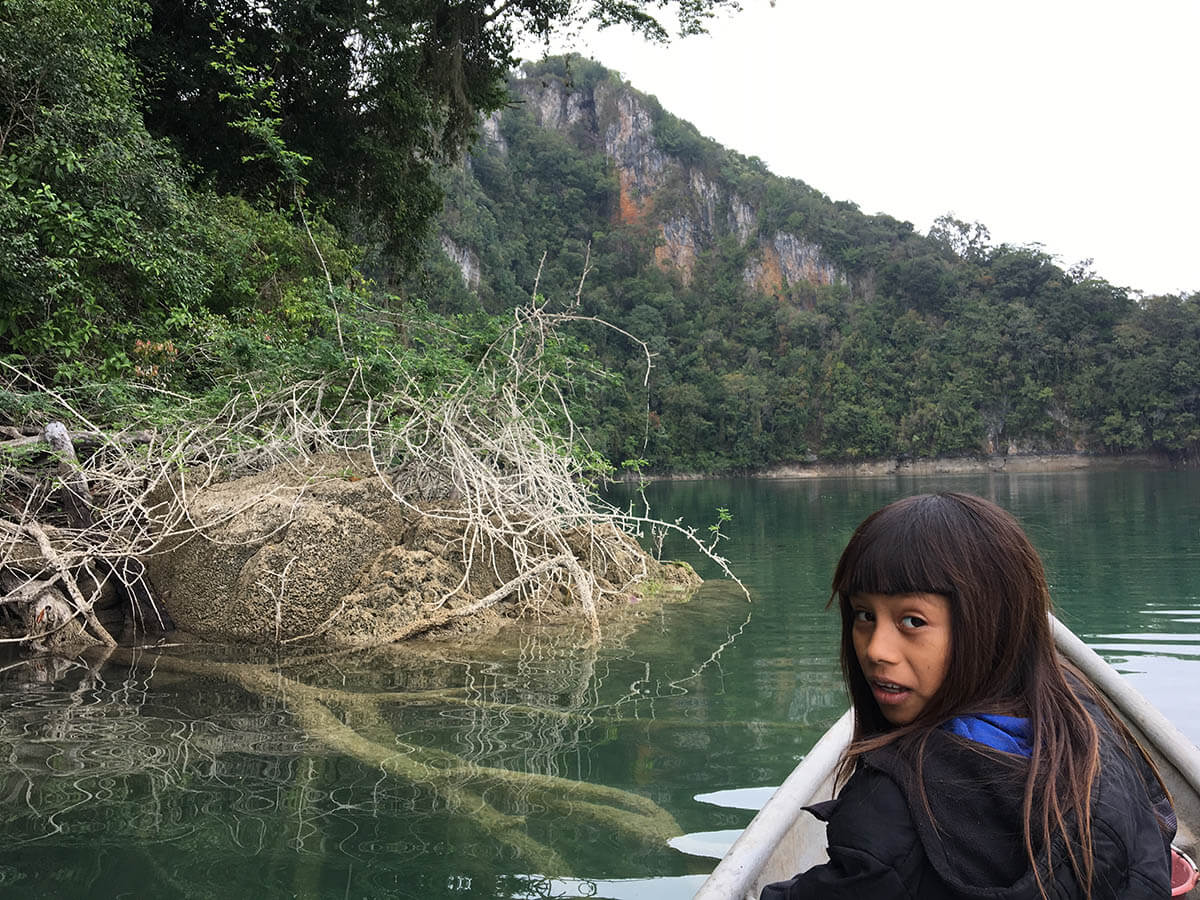
Chan K’in Valenzuela approaches Chäk Aktun mountain in his father’s canoe. A trail at the base of the mountain leads to a lookout point the Lacandones use to monitor encroachment onto their lands. Photo: James D. Nations, 2019
Nature permeates Lacandón lives. Men and women learn to measure time by counting the years in yaax k’in, the “green days” that mark the arrival of spring rains. They determine when to plant their crops by watching the flowering of specific indicator plants in the forest. “When the ek’ balche’ tree (Guatteria anomala) blooms,” they say, “it’s time to plant climbing beans.” Children mark their birthdates by naming the trees that were in flower on the day they were born. Ti u yok puna anchajen, “I was born at the ‘foot’ of the mahogany tree,” they say—in early June, that is, when the mahogany trees were flowering.
Children mark their birthdates by naming the trees that were in flower on the day they were born.
For generations, Lacandón traditions survived and adapted in a rainforest that seemed to go on forever. Their ancestors always lived in the watershed of the Usumacinta River—today the international boundary between Guatemala and Mexico—but they crossed the river into what would become modern Mexico in the eighteenth and nineteenth centuries to escape Spaniards scouring the Guatemalan forest for unconquered Maya families. To avoid violence and disease, the Lacandones fled into a wilderness that soldiers and epidemics had depopulated of its original Ch’ol Maya inhabitants. Living in small family compounds separated by kilometers of primary forest, Lacandones tenaciously held on to their language, religion, and environmental knowledge.
But things change.
In the second half of the twentieth century, the external world literally bulldozed its way into the Lacandón rainforest in search of mahogany and tropical cedar trees to sell to Europe and the United States. Mexican and U.S. logging companies took the trees and left behind roads, opening the way for migrant farm families and cattle ranchers to flow into a forest that the government considered unowned and unoccupied. As decades went by, the newcomers increased in number, and Lacandones concentrated their families into ever smaller circles of forest.
During the seventy years between 1950 and 2020, outsiders cleared and burned two-thirds of the original tropical rainforest and transformed it into corn fields and cattle pastures, leaving climax forest only on inaccessible mountains and cliffs. What was once a forest sparsely occupied by Lacandón families became home to 300,000 farmers and ranchers who migrated there from somewhere else. Today, the only rainforest that survives is that growing in tenuously-protected biosphere reserves and on the lands of the Lacandón Maya.
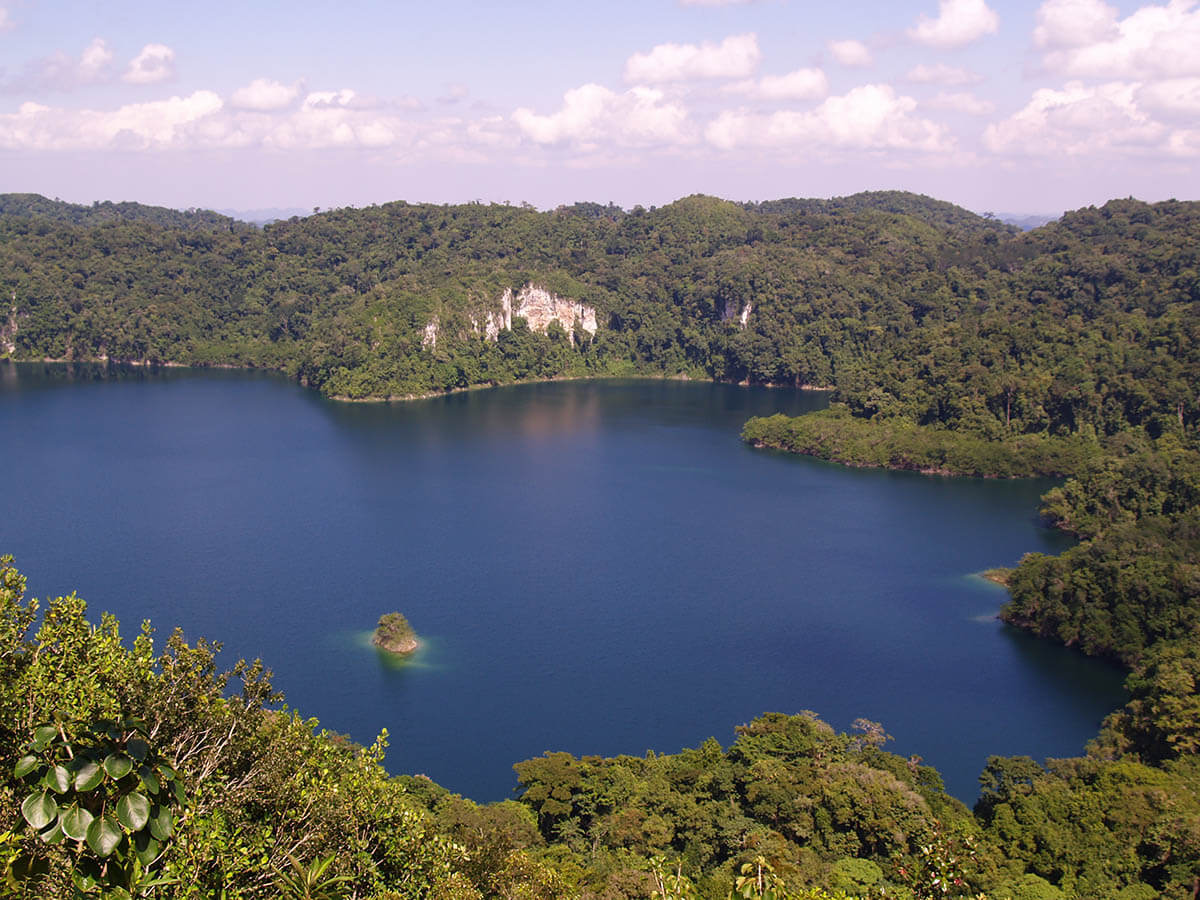
Lake Mensäbäk seen from the Chäk Aktun lookout point. Photo: James D. Nations, 2009
If there is an uncomfortable edge to this story (and there is an uncomfortable edge to this story), it is this: the invading farm families were themselves Indigenous Peoples, more specifically Tzeltal Maya and Ch’ol Maya, some of the latter being the descendants of families wrenched from the forest by invading Spaniards 400 years before. They were refugees fleeing poverty and debt-peonage on plantations and ranches owned by Spanish-speaking families in the Chiapas highlands. What they sought was land and new lives, and they inexorably surrounded the small settlements of Lacandón Maya hiding in the forest, forcing them to concentrate into diminished islands of rainforest.
Many of the Tzeltal and Ch’ol Maya lamented the destruction of resources. But they were doing what anyone would do in their situation—trying to stay alive and feed their children. They were (and are today) farmers of corn, chilies, beans, squash, coffee, and pigs. Today, however, many of them also aspire to be cattle ranchers—small-scale producers, to be sure, but cattle ranchers nonetheless. Year by year, they have gradually transformed the Lacandón rainforest into a mosaic of villages, cornfields, and pasture.
Cattle ranching on thin tropical soils requires huge amounts of land but produces uninspiring yields.
To find the villains in this story (and there are villains in this story), look for the large-scale beef cattle ranchers who use Tzeltal and Ch’ol Maya families as disposable producers of cows and calves for the national and international beef cattle industry. Cattle ranching on thin tropical soils requires huge amounts of land but produces uninspiring yields—an average of ten kilos of beef per hectare (nine pounds per acre) per year. But if an aspiring rancher can get a single cow to market in a good year, he can sell it for 8,000 to 12,000 Mexican pesos (equivalent to about USD$440 to $670 at a 2019 exchange rate)—that is, more than he can earn from almost any other activity available to him.

Beef cattle graze on land formerly covered with tropical rainforest in Chiapas, Mexico. Photo: James D. Nations, 1989
Here’s the frustrating part: what little beef the Tzeltal and Ch’ol families produce rarely becomes food for their own families. Instead, eighteen-wheeler cattle trucks pull into the region every year to purchase the cattle the families produce—a few from this community, a few more from their neighbors. The cattle are driven to slaughterhouses in Mexican cities to fill in for the cattle raised in the drier states of northern Mexico, which are exported to the United States for fattening and consumption. In a nutshell, small-scale Indigenous farmers are used as externalized labor by the national and international livestock industry at the expense of local food production and at the expense of the natural environment.

Colonists and ranchers burn tropical rainforest to plant introduced grasses for beef cattle production in Chiapas, Mexico. Photo: James D. Nations, 2009
.

A Tzeltal Maya colonist fells a buttressed tropical forest tree near the Lacandón community of Mensäbäk, Chiapas, Mexico. Photo: James D. Nations, 2009
If there is to be a future for the Lacandón rainforest, it lies in removing the outside pressures that are impoverishing Maya families and pushing them to live unsustainably on their own land. Promise for some families is emerging in the form of organic coffee production, a half-dozen varieties of agroforestry, and intensified production of crops on land that has already been cleared. But challenges remain for many others. Having replaced the forest in their own communities with pasture for beef cattle, these neighbors sneak into the Lacandones’ forest to poach wildlife to consume and Chamaedorea palm leaves to sell in the international floral trade.
Yet, hope runs high among the Lacandón Maya. In the living foam of tradition and change that characterizes modern Lacandón society, a “through line” of forest conservation continues to thread its way. In 1998, Mexican law allowed communities to declare their lands Áreas de Conservación de Flora y Fauna (Flora and Fauna Conservation Areas), and Lacandones seized the opportunity, giving themselves the legal and moral authority to prevent illegal encroachment and wildlife poaching in their forest.
In the living foam of tradition and change that characterizes modern Lacandón society, a ‘through line’ of forest conservation continues to thread its way.
Working with the Consejo Nacional de Áreas Naturales Protegidas, (CONANP, the National Council of Natural Protected Areas), Lacandón communities established their own zoning and land-use rules. They continue to practice their widely-admired agroforestry system, which rotates staple food crops—corn, beans, squash, and chilies—with tree crops such as avocado, mamey, and papaya in an efficient use of land, time, and labor, but they do not clear primary forest. Instead, they cultivate fallowed plots of secondary forest. They eat fish and raise chickens and turkeys, but do not kill forest wildlife unless it threatens human life or food crops.
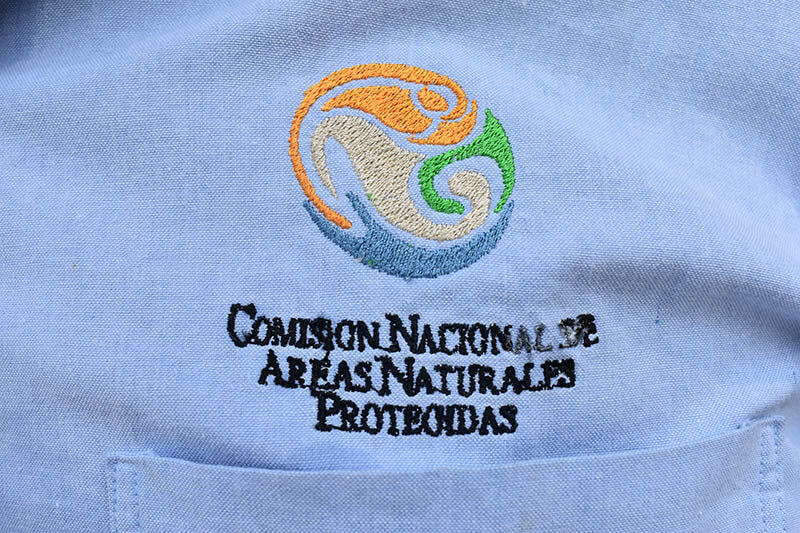
Lacandón park guards wear the logo of CONANP, Mexico’s National Council for Natural Protected Areas. Photo: James D. Nations, 2019
To ward off intruders, Lacandón park guards and state environmental police, whose salaries are paid by the federal and state governments, conduct regular patrols of their forest territories, arresting intruders caught stealing natural resources. Some of the Lacandón guards wear traditional clothing—a white cotton tunic hanging to the knees, rubber boots, long hair grown past their shoulders.

Rafael Tárano prepares a canoe for a conservation patrol at Lake Mensäbäk. Photo: James D. Nations, 2019
Others sport crew cuts and Western clothes—long pants, long-sleeved shirts, t-shirts, and leather boots. But all of them—both men and women—wear shirts or vests stamped with the logos of the CONANP or the Policía Estatal de Chiapas (Chiapas State Police). Most days, they do not carry firearms—only defensive, side-handle batons and handcuffs—but they know they have the force of the law behind them. As a result, wildlife populations in their territories are the healthiest they have been since the 1970s.

Lacandón Maya park guards and state police launch canoes to patrol the lakes of their home community of Mensäbäk. Left to right: Humberto Salórzano, José Angel Salórzano, Gustavo López, Freddy Valenzuela. Photo: James D. Nations, 2019
When a patrol comes upon a poacher, one Lacandón policewoman told me, “He usually drops everything and runs away, but if we recognize them, we go to their community and denounce them.”
“The challenges come from lax law enforcement,” a CONANP guard added. “Their community arrests them, and they may serve a couple of months in jail, but they’re soon back at home and sneaking into our forest to steal palm leaves and kill animals. There’s not enough enforcement of the law after people are arrested.”
In the past, Lacandón Maya took week-long pilgrimages through the forest to visit sacred sites encased in nine centuries of regrowing trees and hanging vines. They burned copal incense before stone carvings of ancient Maya rulers they had re-envisioned as gods. Modern poaching patrols are not all that different. Lacandones still hike the rainforest, observing the birds, the fish, the levels of the lake, vigilant for signs of change. Today, they blend data from topographical maps and digital cameras with knowledge gathered while hunting with their fathers and from folktales told around the fire. Contemporary Lacandones carry walkie-talkies instead of bows and arrows.
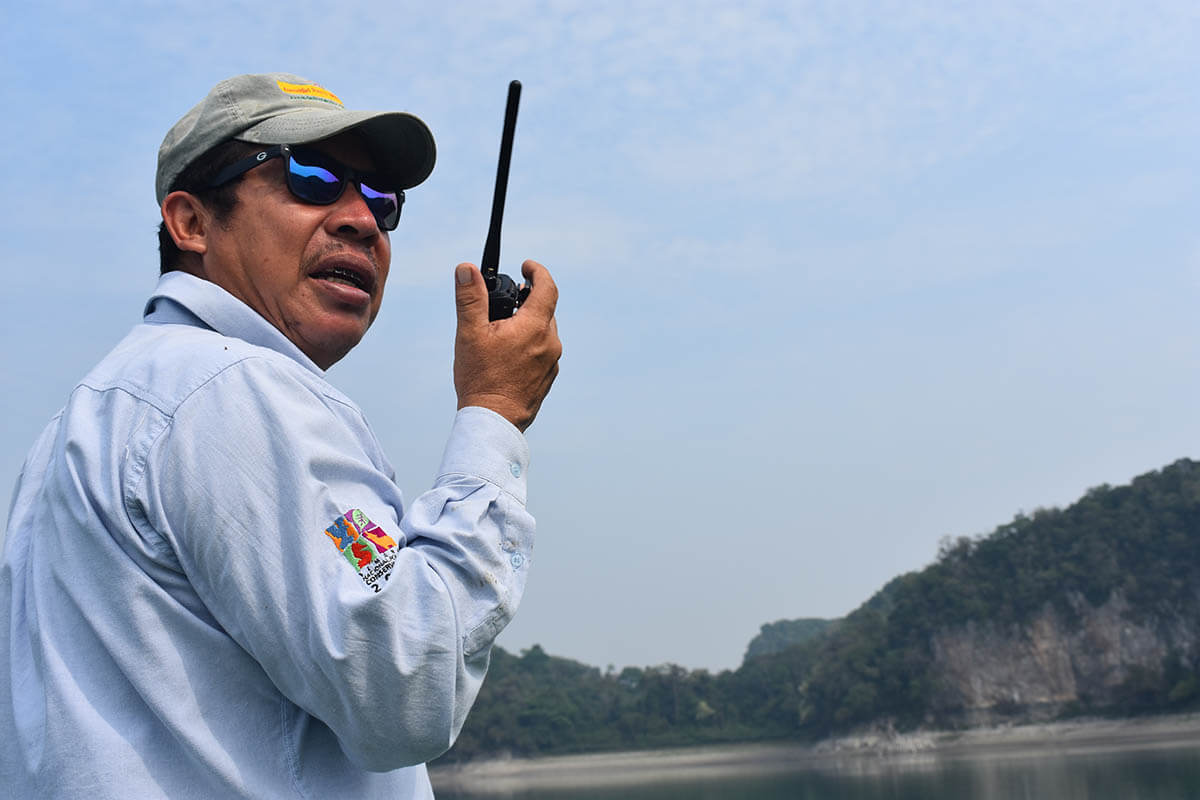
Enrique Valenzuela communicates via walkie-talkie with other Lacandón park guards while on conservation patrol at Lake Ts’ibanaj. Photo: James D. Nations, 2019
Careers as CONANP guards and environmental police are not the only two ways in which Lacandones are benefiting from their knowledge of the forest. In addition, families have built ecotourism lodges and restaurants to accommodate national and international tourists drawn to see their forest, lakes, and ruins. Lacandones want to develop tourism because they “believe that their past and current lifeways are important for outsiders to learn about and that their forest communities should be shared with the world,” says archaeologist Joel Palka, who works with the Lacandón Maya and Mexico’s National Institute of Anthropology and History.
Lacandones want to develop tourism because they “believe that their past and current lifeways are important for outsiders to learn about and that their forest communities should be shared with the world.”
In Lacanja’ Chan Sayab, a dozen families offer rustic lodging, camping, rafting trips, and guided hikes to Bonampak. Young Lacandón men in traditional white tunics, their long hair pulled back in a ponytail, lead wide-eyed tourists down rainforest trails past waterfalls and Maya ruins, speaking fluent Spanish, citing bird names in their native language and promoting conservation values. Some of the lodges and restaurants in Lacanja’ Chan Sayab were built with support from Mexico’s Instituto Nacional de Pueblos Indígenas (National Institute of Indigenous Peoples) and the Secretaría del Turismo (Department of Tourism), but they are owned and operated by Lacandón Maya. Tourists can sign up for kayak and rafting expeditions with companies in the Chiapas towns of San Cristóbal las Casas and Palenque, but when the tourists reach the rainforest it’s Lacandones who are in charge.
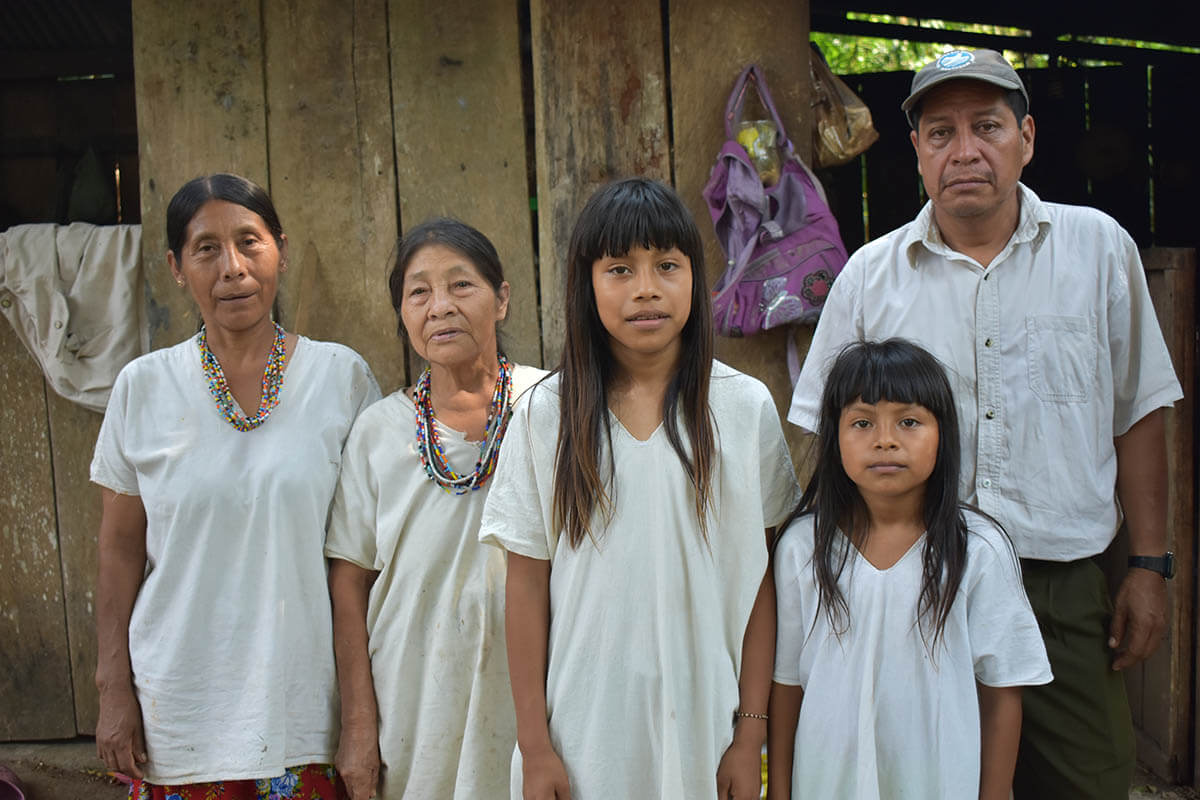
Eva (center) and her daughter Nuk (on left) with relative Minchu Valenzuela and his sons, Chan K’in and Bor. The women craft traditional bark cloth bags to sell to visitors. Photo: James D. Nations, 2019
As the legal owners and protectors of the last tropical rainforest in Mexico, Lacandón Maya have transformed their centuries-old traditions of forest and wildlife conservation into the economics of environmental protection. Their through line of respect for nature continues, and their rainforest is still alive.
To learn more about the Lacandón Maya, see To the Roots: A Maya Reunion, a film by Steve Bartz.
.
Back to Vol. 9 | Read the Table of Contents | Like Our Stories? Please Donate!
.
 .
.
James D. Nations, an ecological anthropologist, has been learning from Lacandón Maya families for more than forty years. He is the author of The Maya Tropical Forest: People, Parks, and Ancient Cities; Lacandón Maya: The Language and the Environment; and the forthcoming Rainforest, Roads, Resilience: Lacandón Maya in the 21st Century. Read more from James D. Nations.




